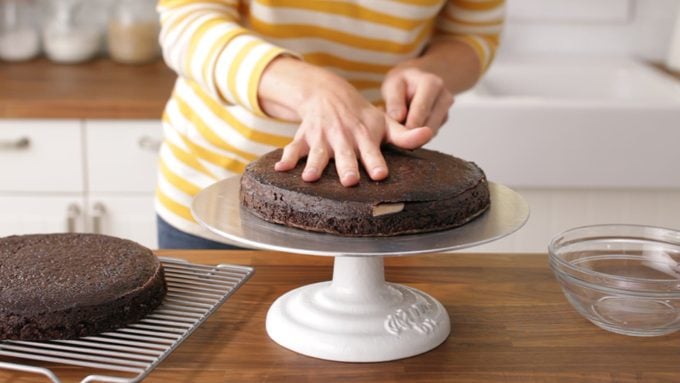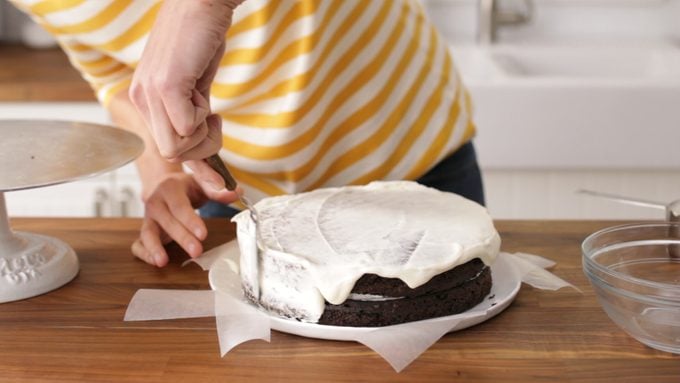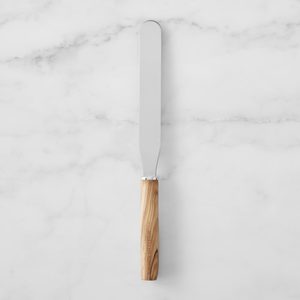What Is a Naked Cake—and How You Can Master This Decorating Trend at Home
Updated: Jul. 15, 2022
Cake fanatics, try this new frosting technique: the naked cake. With barely-there icing, you can see all the goodness you're about to slice into.
Cakes are arguably the most important part of any celebration. It wouldn’t be a birthday, wedding or baby shower without one.
While many of us have come to expect over-the-top decoration on these multi-layered wonders, there is a different approach for decorating cakes—something a bit more minimal. That’d be naked cakes!
What Are Naked Cakes?

Naked cakes are layer cakes that are unadorned (or nearly bare) on the sides. That’s right: no swoops of frosting or colorful iced patterns. Instead, the cakes are stacked up with frosting or filling between each layer. Sometimes that’s it and sometimes the cakes get a very thin layer of frosting on the exterior to hold everything in—that’s called a crumb coat. It’s a common step for frosting cakes (though most still get more frosting on top).
Without the typical outer layer of frosting, the interior of the cake is exposed—meaning you get a sneak peek of all the delicious flavors inside.
Where Did Naked Cakes Come From?
After ages of frosting-laden cakes, you have to wonder where the idea to strip these cakes bare came from? Well, we have cake queen Christina Tosi, founder and owner of Milk Bar, to thank for the popularity of naked cakes.
In 2014, this famous baker started selling towering cakes without any exterior icing so customers could see all the decadent cake, icing, crunchy cookie bits and more inside.
Two years later, Angelina Jolie and Brad Pitt served a naked cake at their wedding and bam! Faster than you can say “hold the frosting,” naked cakes were everywhere.
Why Should You Try a Naked Cake?

If you’re an avid cake baker or someone that likes to experiment in the kitchen, you should absolutely try making a naked cake. Trying out a new technique for decorating cakes is always fun—and delicious.
Naked cakes are also great for those that love cake but don’t always love the heaps of frosting that go with it. If you’re a frosting fanatic, however, you’ll likely want to stick with a classic layer cake that’s iced on all sides.
How to Frost a Naked Cake
There’s lots of good news when it comes to making a naked cake at home. First is that to make a naked cake, you can use any layer cake recipe you want. Any of these cakes can become a naked cake!
The other bit of good news is that if you can frost a regular layer cake, making a naked cake will be no problem at all! And even if frosting isn’t your forte, you’ll be able to master this technique in a jiff.
The Tools You’ll Need
To frost a naked cake at home, you’ll need just a few tools—many of which are cake decorating basics.
- Icing spatula: An icing spatula can be used to smooth out the filling and icing between the layers of the cake and give the naked cake its barely-there exterior icing.
- Cake turntable: To get a really even and thin coat of icing, a cake turntable is a great tool to have. With each spin, you can skim off any extra frosting and make sure the sides are perfectly straight.
- Cake scraper: For super straight sides on layer cakes, this tool comes in handy. Paired with the turntable, you can crumb coat a cake in seconds. Don’t have time to order one of these tools? A regular bench scraper will work just fine for shorter cakes.
Step 1: Level the Cakes

The basis for a perfectly straight and even naked cake is level cake layers. There are lots of ways to produce level cakes both before and after baking.
Catherine Ward in our Test Kitchen swears by these cake strips that you wrap around the cake pans before they even go in the oven.
You can also level layers after they’ve been baked. Once the cakes are cooled, take a bread knife and carefully slice away the domed top of the cake. With a flat surface, stacking up each layer and filling will be much easier.
Step 2: Stack the Layers and Filling

Next, layer up the cake just like you would any layer cake. That means adding plenty of frosting, ganache or other fillings between each layer.
Step 3: Crumb Coat

For the traditional naked cake look, you’ll want to take the decoration one step further by adding a very thin layer of icing on the outside of the cake. Enough to trap any crumbs but thin enough to let the cake peek through.
Start by spreading a very small amount of icing on the top and sides of the cake with a spatula. Then carefully turn the cake to spread and scrape the frosting across the cake, making sure you can see through to all the layers inside.
Step 4: Store
Because naked cakes leave more cake exposed, they can dry out faster than traditionally iced desserts. To keep the cake moist, just be sure to store it under a cake dome or in a sealed cake carrier.










